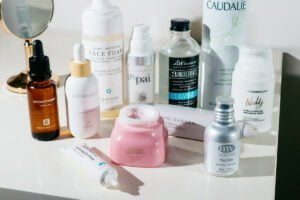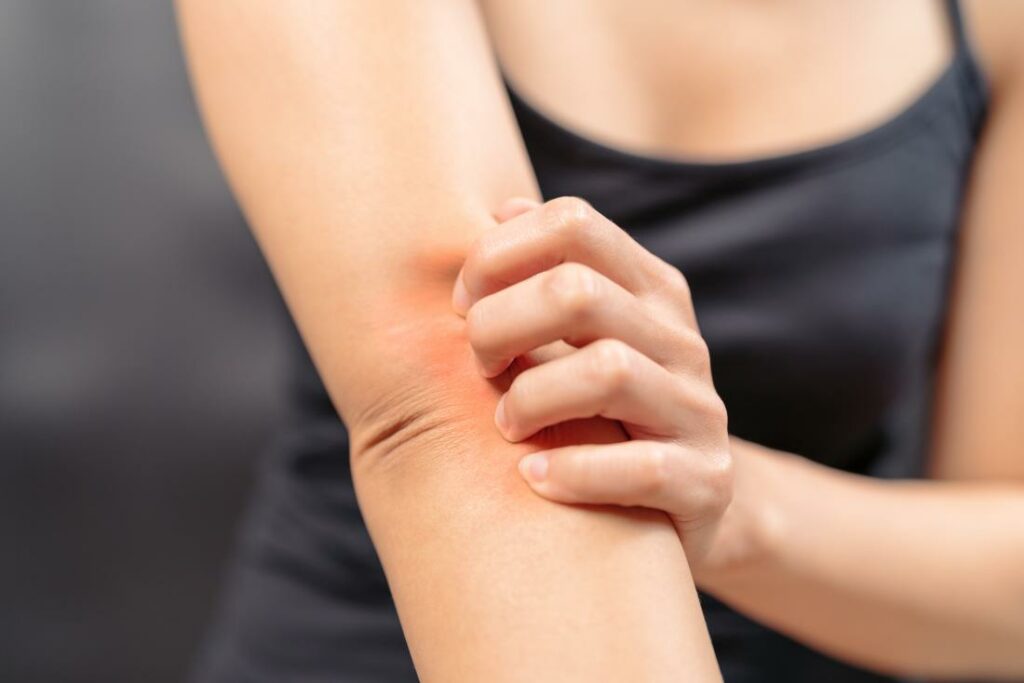Menopause is a natural and inevitable stage in a woman’s life, signaling the end of her reproductive years. While this transition is accompanied by various physical and emotional changes, some women may also experience unexpected skin issues, such as menopause rash. Menopause rash can be distressing, affecting not only the skin but also a woman’s overall well-being. In this blog, we will delve into the causes, symptoms, and most importantly, effective treatment for menopause rash.
Contents
What Does “Menopause Rash” Mean?

“Menopause rash” refers to a skin condition that some women may experience during the menopausal transition. Menopause is a natural biological process that marks the end of a woman’s reproductive years. It typically occurs around the age of 45 to 55, and during this time, the body undergoes significant hormonal changes, particularly a decline in estrogen levels.
- The hormonal fluctuations associated with menopause can have various effects on the body, including the skin.
- Some women may notice changes in their skin, and in some cases, a rash may develop.
- Menopause rash, also known as hormonal rash or menopausal dermatitis, is characterized by red, itchy, and inflamed patches on the skin.
These rashes commonly appear on areas such as the face, neck, chest, and arms.
- The exact cause of menopause rash is not fully understood, but hormonal changes are believed to play a significant role.
- As estrogen levels decrease, the skin may undergo alterations in its structure and moisture balance, making it more susceptible to irritation.
- Additionally, dry skin is a common symptom during menopause, and this dryness can contribute to the development of rashes.
It’s important to note that not all women going through menopause will experience a rash, and the severity and duration of symptoms can vary from person to person. If a woman is experiencing bothersome skin issues during menopause, it is advisable to consult with a healthcare professional or a dermatologist for a proper diagnosis and appropriate treatment options.
Treatment Options for Menopause Rash
The treatment of menopause rash typically involves a combination of skincare practices, lifestyle adjustments, and, in some cases, medical interventions. It’s important to note that the effectiveness of treatment may vary among individuals, and consulting with a healthcare professional or dermatologist is crucial for personalized advice. Here are some common treatment options for menopause rash:
Topical Steroids
Topical steroids are a common and effective treatment option for managing menopausal rash, also known as menopausal dermatitis or hormonal rash. These medications belong to a class of drugs called corticosteroids, and they work by reducing inflammation, redness, and itching associated with various skin conditions, including rashes related to hormonal changes during menopause.
Here’s a closer look at how topical steroids are used as treatment options for menopause rash:
How Topical Steroids Work:
Anti-Inflammatory Action:
- Topical steroids have anti-inflammatory properties, which means they can help suppress the inflammatory response in the skin.
- In the context of menopause rash, where inflammation contributes to redness, swelling, and itching, the anti-inflammatory action of steroids can provide relief.
Immunosuppressive Effects:
- Corticosteroids also have immunosuppressive effects, which help modulate the immune response in the skin.
- This can be beneficial for conditions where the immune system plays a role in triggering or exacerbating skin symptoms.
How Topical Steroids Are Applied:
Prescription-Based:
- Topical steroids are available both over-the-counter (OTC) and as prescription medications.
- The strength and potency of the steroid can vary, and prescription-strength formulations are typically used for more severe cases.
Application Guidelines:
- Dermatologists or healthcare professionals provide specific guidelines on how to apply the medication.
- Generally, a thin layer of the topical steroid is applied to the affected areas of the skin.
Short-Term Use:
- Topical steroids are often prescribed for short-term use to manage acute flare-ups of menopause rash.
- Prolonged or excessive use of potent steroids can lead to side effects, such as skin thinning or discoloration.
Antihistamines
Antihistamines are commonly used as treatment options for menopause rash, particularly to alleviate itching associated with the condition. Menopause rash, or menopausal dermatitis, can often lead to significant discomfort due to redness, inflammation, and itching of the skin. Antihistamines work by blocking the action of histamine, a compound released in the body in response to allergens or other triggers, and are known to cause itching.
Here’s a closer look at how antihistamines are used in the treatment of menopause rash:
How Antihistamines Work:
Histamine Blockade:
- Histamine is a chemical released by cells in response to allergens or irritants, leading to various allergic reactions, including itching.
- Antihistamines work by blocking the effects of histamine, reducing itching and other symptoms associated with allergic reactions.
Symptom Relief:
- Antihistamines are particularly effective in providing relief from itching, which is a common symptom of menopause rash.
- By reducing the histamine response, antihistamines can help alleviate the discomfort associated with the rash.
Types of Antihistamines:
First-Generation Antihistamines:
- Examples include diphenhydramine (Benadryl), chlorpheniramine, and hydroxyzine.
- These antihistamines may cause drowsiness and are often taken before bedtime.
Second-Generation Antihistamines:
- Examples include cetirizine (Zyrtec), loratadine (Claritin), and fexofenadine (Allegra).
- Second-generation antihistamines are less likely to cause drowsiness and are often preferred for daytime use.
Stress Management

tress management is an important and often overlooked aspect of treating menopause rash. The hormonal changes and psychological aspects associated with menopause can contribute to increased stress levels, which, in turn, may exacerbate skin conditions, including menopause rash. Implementing stress management techniques can have a positive impact on both mental well-being and skin health. Here’s how stress management can be a valuable treatment option for menopause rash:
Stress Management Techniques:
Mindfulness Meditation:
- Mindfulness meditation involves being fully present in the moment, which can help reduce stress and promote a sense of calm.
- Practices like deep breathing, body scan, and guided meditation can be beneficial.
Yoga:
- Yoga combines physical postures, breath control, and meditation, offering a holistic approach to stress reduction.
- Regular yoga practice has been shown to reduce stress and improve overall well-being.
Deep Breathing Exercises:
- Deep breathing exercises can activate the body’s relaxation response, reducing stress levels.
- Techniques like diaphragmatic breathing or progressive muscle relaxation can be effective.
Exercise:
- Regular physical activity can have a positive impact on both mental and physical health.
- Engaging in activities like walking, jogging, or swimming can help alleviate stress and improve mood.
Counseling or Therapy:
- Talking to a mental health professional can provide a supportive space to address and manage stressors.
- Cognitive-behavioral therapy (CBT) is a common approach that helps individuals change negative thought patterns and behaviors.
Social Support:
- Maintaining strong social connections and seeking support from friends, family, or support groups can help alleviate stress.
- Sharing experiences and concerns with others going through similar situations can be comforting.
Integrating Stress Management into Overall Treatment:
Comprehensive Approach:
- Stress management should be viewed as part of a comprehensive treatment plan for menopause rash.
- Combining stress reduction techniques with skincare practices, such as moisturizing and avoiding irritants, can lead to better outcomes.
Consistency is Key:
- Consistency in practicing stress management techniques is crucial for long-term benefits.
- Integrating stress-reducing activities into daily routines can contribute to overall well-being.
Moisturize Regularly
Regular moisturizing is a fundamental and effective treatment option for managing menopause rash. The hormonal changes associated with menopause often lead to dry and sensitive skin, which can contribute to the development or exacerbation of rashes. Moisturizing plays a crucial role in maintaining skin hydration, preventing dryness, and reducing itching and irritation. Here’s a detailed look at how moisturizing can be a key component of the treatment plan for menopause rash:
Importance of Moisturizing:
Skin Barrier Support:
- Moisturizers help reinforce the skin barrier, which can be compromised during menopause due to reduced oil production.
- A healthy skin barrier is essential for protecting against irritants, and allergens, and preventing moisture loss.
Hydration Maintenance:
- Menopausal changes can lead to decreased skin hydration, making the skin more prone to dryness and itching.
- Regular moisturizing helps maintain optimal skin hydration levels.
Itch Reduction:
- Dry skin is often associated with itching, and moisturizers can provide relief by reducing the sensation of itchiness.
- By keeping the skin well-hydrated, moisturizers contribute to breaking the itch-scratch cycle.
Promoting Comfort:
- Moisturized skin feels more comfortable and supple, providing relief from the discomfort associated with menopause rash.
Choosing the Right Moisturizer:
Hypoallergenic Formulations:
- Opt for hypoallergenic and fragrance-free moisturizers to minimize the risk of skin irritation.
- Fragrances and certain additives can trigger or worsen skin reactions in sensitive individuals.
Rich Emollients:
- Choose moisturizers with rich emollients, such as ceramides, fatty acids, and glycerin, to provide deep hydration and nourishment to the skin.
Creams or Ointments:
- Creams and ointments are often more effective than lotions for individuals with dry skin.
- Ointments have a thicker consistency and provide a more occlusive barrier, preventing water loss from the skin.
Non-Comedogenic:
- Ensure that the moisturizer is non-comedogenic to prevent clogging of pores, especially for individuals prone to acne or skin breakouts.
Gentle Skincare

Gentle skincare practices are essential for managing menopause rash, as the skin changes during this phase, becoming more sensitive and prone to irritation. The hormonal fluctuations associated with menopause can lead to dryness, itching, and inflammation, making it crucial to adopt a gentle and nurturing approach to skincare. Here’s a detailed overview of how gentle skincare can be a vital treatment option for menopause rash:
1. Use Mild Cleansers:
- Opt for mild, fragrance-free cleansers that do not strip the skin of its natural oils.
- Avoid harsh soaps or cleansers with strong detergents, as they can contribute to skin dryness and irritation.
2. Avoid Hot Water:
- Use lukewarm water for bathing and washing the face.
- Hot water can strip the skin of its natural oils, leading to increased dryness and sensitivity.
3. Pat, Don’t Rub:
- Gently pat the skin dry with a soft towel after washing, rather than rubbing vigorously.
- This helps prevent additional irritation and friction on the skin.
4. Choose Hypoallergenic Products:
- Opt for hypoallergenic and fragrance-free skincare products to minimize the risk of allergic reactions.
- Fragrances and certain additives can be irritating to sensitive skin.
Sun Protection
Sun protection is a crucial component of the treatment plan for menopause rash, helping to prevent further irritation and damage to the skin. The hormonal changes during menopause can make the skin more susceptible to the harmful effects of ultraviolet (UV) radiation from the sun. Incorporating sun protection measures is essential to manage menopause rash and maintain overall skin health. Here’s a detailed look at the importance of sun protection as a treatment option:
1. UV Radiation and Skin Sensitivity:
- Ultraviolet radiation from the sun can exacerbate skin sensitivity and contribute to the development or worsening of menopause rash.
- UV exposure can lead to inflammation, redness, and increased dryness, making it crucial to protect the skin.
2. Choose a Broad-Spectrum Sunscreen:
- Select a broad-spectrum sunscreen that protects against both UVA and UVB rays.
- UVA rays can contribute to premature aging and may be linked to certain skin conditions, while UVB rays are associated with sunburn.
3. Use Sunscreen with SPF 30 or Higher:
- Opt for a sunscreen with a sun protection factor (SPF) of 30 or higher.
- Higher SPF values provide increased protection against UVB radiation.
4. Apply Sunscreen Generously:
- Apply sunscreen generously to all exposed skin, including the face, neck, chest, and arms.
- Ensure even coverage and reapply as needed, especially if sweating or spending extended periods outdoors.
Conclusion
In conclusion, addressing menopause rash requires a multifaceted approach, where gentle skincare, regular moisturizing, stress management, and sun protection play pivotal roles.
Consulting healthcare professionals ensures personalized guidance, fostering a holistic and proactive approach to skin health during this transformative life stage. Empowered with knowledge and tailored care, women can embrace menopause with comfort and confidence.
If you are facing menopause-related issues, menopause treatment at HerMantra can help. Book your free trial online menopause treatment session now.


